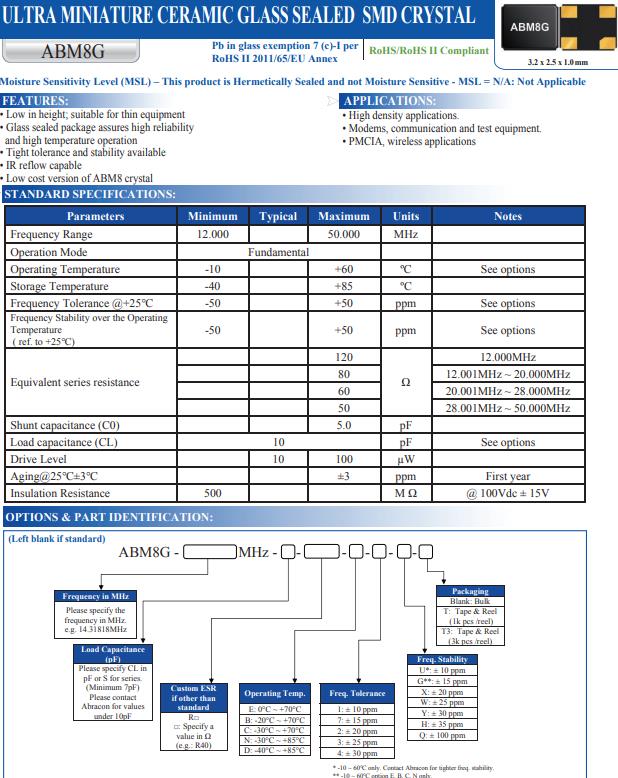86-0755-27838351
高性价比的石英晶体谐振器超级适合用于儿童手表ABM10-20.000MHZ-E20-T,电感器的直流电阻受环境温度和电感体固有自热的影响。图2为AMXLA-Q1040系列的DCR随环境温度升高而升高的变化情况。从图中可以看出,石英晶振和大电感值的DCR比小电感值受温度的影响更大。然而,作为DCR的百分比变化,从25°C到最大180°C的温度变化将导致DCR约60%的线性增加,而不管电感值如何。
 高性价比的石英晶体谐振器超级适合用于儿童手表ABM10-20.000MHZ-E20-T,例如,68uH电感在25°C时的DCR≈210mΩ。增加60%的直流电阻,在180°C下计算大约为336mΩ。作为比较,47uH电感在25°C时的DCR≈145mΩ,而在高温时的DCR≈232mΩ。
高性价比的石英晶体谐振器超级适合用于儿童手表ABM10-20.000MHZ-E20-T,例如,68uH电感在25°C时的DCR≈210mΩ。增加60%的直流电阻,在180°C下计算大约为336mΩ。作为比较,47uH电感在25°C时的DCR≈145mΩ,而在高温时的DCR≈232mΩ。
DCR的增加通过增加直流损耗对电感的性能产生负面影响。随着额外的损耗,产生更多的自热,这是在扩展温度应用中降额电感的主要原因。因而贴片晶振也为广泛应用程序带来极大的便利。
| Manufacturer Part Number 原厂编码 | Manufacturer厂家 | Series型号 | Type 系列 | Frequency频率 | Package / Case包装/封装 |
| ABM3C-24.576MHZ-D4Y-T | Abracon晶振 | ABM3C | MHz Crystal | 24.576MHz | 4-SMD, No Lead |
| ABM3C-14.31818MHZ-D4Y-T | Abracon晶振 | ABM3C | MHz Crystal | 14.31818MHz | 4-SMD, No Lead |
| ABS06L-32.768KHZ-T | Abracon晶振 | ABS06L | kHz Crystal (Tuning Fork) | 32.768kHz | 2-SMD, No Lead |
| ABMM-11.0592MHZ-B2-T | Abracon晶振 | ABMM | MHz Crystal | 11.0592MHz | 4-SMD, No Lead |
| ABM8G-14.31818MHZ-B4Y-T | Abracon晶振 | ABM8G | MHz Crystal | 14.31818MHz | 4-SMD, No Lead |
| ABM8G-13.000MHZ-B4Y-T | Abracon晶振 | ABM8G | MHz Crystal | 13MHz | 4-SMD, No Lead |
| ABM8G-30.000MHZ-B4Y-T | Abracon晶振 | ABM8G | MHz Crystal | 30MHz | 4-SMD, No Lead |
| ABM8G-33.000MHZ-B4Y-T | Abracon晶振 | ABM8G | MHz Crystal | 33MHz | 4-SMD, No Lead |
| ABM8G-20.000MHZ-B4Y-T | Abracon晶振 | ABM8G | MHz Crystal | 20MHz | 4-SMD, No Lead |
| ABS07-LR-32.768KHZ-6-T | Abracon晶振 | ABS07-LR | kHz Crystal (Tuning Fork) | 32.768kHz | 2-SMD, No Lead |
| ABM10-27.000MHZ-E20-T | Abracon晶振 | ABM10 | MHz Crystal | 27MHz | 4-SMD, No Lead |
| ABM10-20.000MHZ-E20-T | Abracon晶振 | ABM10 |
3225贴片晶振 |
20MHz | 4-SMD, No Lead |
| ABLS-LR-4.9152MHZ-T | Abracon晶振 | ABLS-LR | MHz Crystal | 4.9152MHz | HC49/US |
| ABM10-25.000MHZ-E20-T | Abracon晶振 | ABM10 | MHz Crystal | 25MHz | 4-SMD, No Lead |
For example, the 68uH inductor has a DCR ≈ 210m? at 25°C. Adding 60% more DC resistance calculates to approximately 336m? at 180°C. For comparison, the 47uH inductor has a DCR ≈ 145m? at 25°C and a high temp DCR ≈ 232m?.
The increase in DCR negatively affects the inductor’s performance by increasing DC loss. With the additional loss, more self-heating is generated and is the primary reason for derating inductors in extended temperature applications.